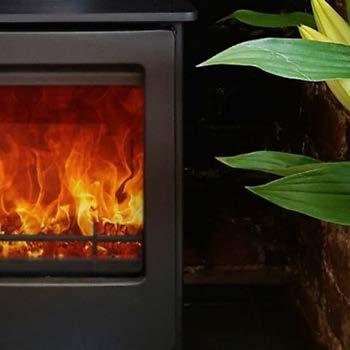
4 minute read
Wood burners vs air quality - going beyond the headlines
With domestic wood burning taking another pounding in the mainstream press, the Stove Industry Alliance (SIA) has taken a look at the facts in order to determine what the data from air quality monitoring sites in and around London actually tells us.
By Erica Malkin - SIA Communications Manager
Advertisement
There’s a famous Mark Twain quote about statistics that I am sure has been uttered by many of us in the wood burning stove industry lately. I used it myself in a conversation with a colleague after what had been a particularly busy day recently spent fielding requests from the media for comment about the release of the latest data on emissions of air pollution by Defra.
Reading the press headlines and hearing the broadcasted debates that have followed since the Defra data went live, you could be forgiven for thinking that enjoying the warmth, comfort, and cost-effective energy security that our wood burning stoves offer is something we must never, ever confess to; especially if we live in London!
So, with Mr Twain’s words in mind, I decided to take a closer look at what air quality monitoring data tells us about what is happening in London when it comes to air pollution.
London is not short of air quality monitoring information. The London Air website, a platform run by Imperial College London, holds data from no less than 131 monitoring sites located across the capital. You can interrogate the data for each of these sites using the drop-down boxes within the monitoring section of the website with the ability to select air pollutants, including PM2.5 and PM10 particulates and nitrogen dioxide (NO2), and display the data for each by individual monitoring site.
Given the headlines we have been reading lately and the campaigning by groups such as Mums for Lungs and Global Action Plan, I was keen to see if the data backs up the negative rhetoric around pollution from wood burning in modern Ecodesign stoves, so I set about logging the annual mean values (ug/m3) recorded for PM2.5, PM10 and NO2 for all sites (where available) for 2022 and 2023.

And a very interesting picture emerged …
• PM2.5 (tiny particles caused by things like construction, road traffic, aviation and shipping, agriculture, domestic and commercial combustion, outdoor burning, and wildfires) values in 2022 at every London monitoring site that has information for last year (22 in total) were below the current UK legal limit of 20ug/m3 annual mean, without exception.
• For 2023 year to date, 41 out of 42 sites record levels below the UK legal limit, with the average being 13 ug/ m3.
• 7 out of the 42 sites monitoring PM2.5 record 2023 YTD levels as falling within the much lower previous WHO recommended limit of 10 ug/m3 annual mean.
• In 2022 the average PM2.5 level recorded across all sites was 10 ug/ m3 which means London met the WHO recommended limit (at that time) last year.
• For PM10 there is not a single monitoring site showing levels this year or last that exceed the current
UK limit of 40 ug/m3 and, again, many are within the WHO recommended limit which is HALF current UK limit at 20 ug/m3.
Taking a closer look, the 2022 average for PM10 was 19 ug/m3 (across 39 sites), and this year so far, the figure sits slightly higher 21 ug/ m3 meaning that last year the WHO recommended level for PM10 was met and that this year so far is falls only slightly short.
Turning our attention to NO2 and there is less reason to be optimistic. So far this year 19% of monitoring sites in London show breaches of the UK limit of 40 ug/m3 for NO2 –emissions mainly stemming from road transport. Of the 109 sites with data recorded for NO2, 21 sites went over, and the average across all sites is 34 ug/m3 which, while within current UK limits, falls way short of the WHO recommended level of 20 ug/m3 annual mean.
Worse still, 2023 NO2 average levels YTD are above the 2022 average of 26 ug/m3 and that’s despite Sadiq Khan’s ULEZ expansion over recent years.
It is important that we all play a part in reducing emissions, and by replacing a solid fuel open fire or older closed stove with a modern clearSkies 4 or 5 certified stove we can reduce emissions from burning wood at home for heat significantly by up to 90%. That’s a huge reduction from a single sector.

Such a potential reduction is important news when it comes to air quality. So too is the fact that when it comes to PM2.5 and PM10 in London the data from all the monitoring sites listed on the London Air website shows that current UK limits are being met, and that last year’s average PM2.5 levels met the WHO recommended limit (at the time) of 10 ug/m3. Some of the LAQN monitoring sites even recorded annual mean PM2.5 concentration levels last year that come close to the new WHO recommendation of 5 ug/m3.
It’s not easy to find a single newspaper column inch reporting on this though.
It is easy however to find press articles telling us about the “shame” of “wood burner” pollution, but very few media commentators bother to point out the fundamental technical differences between open fires, older closed stoves and modern, Ecodesign compliant closed stoves. They rely instead on the catch-all term “wood burners” and in doing so miss important facts in their reporting.
Of course, we must all strive for better when it comes to reducing emissions. It is modern, technically advanced stoves, coupled with effective stove user education, Smoke Control Area enforcement and industry regulation, that are the key to helping us do better and reduce air pollution linked to indoor domestic combustion. As the recently published Environmental Improvement Plan points out, it is vital that we “Design and implement measures to drive a shift away from older, more polluting appliances, to newer appliances which meet our tough new emission standards.”
To effectively communicate the facts about air pollution relating to indoor domestic combustion we must not only report on domestic combustion methods accurately, but we must also look beyond the headlines and study the air quality monitoring data. That really is the only way we can ensure that valuable statistical information is not spun to suit a particular agenda but is instead presented exactly as it is.










